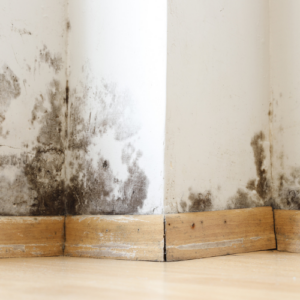Exposure to mold spores can seriously affect individuals, posing a significant health concern. This is true especially in environments with water damage or high humidity, such as Raliegh, North Carolina.
Mold can grow almost anywhere indoors and outdoors, thriving in damp conditions and spreading through the release of tiny spores into the air. Over 77% of homes in North Carolina have crawl spaces and this is a common space to find mold spores.
While some people may only experience mild allergic reactions, others can develop more severe health issues due to prolonged exposure. Recognizing the warning signs of mold toxicity is crucial for early intervention and prevention of potential long-term health problems.
Here are 10 Warning Signs of Mold Toxicity
1. Allergic Reactions
One of the most common initial signs of mold toxicity is an allergic reaction. When exposed to mold spores, susceptible individuals may experience symptoms such as:
sneezing
coughing
wheezing
itchy eyes
runny or congested nose
These symptoms mimic typical seasonal allergies but persist beyond typical allergy seasons, especially if there’s ongoing mold exposure.
2. Respiratory Issues
Beyond mild allergies, mold exposure can lead to more serious respiratory problems. Inhalation of mold spores can irritate the respiratory tract, causing throat irritation, coughing, and difficulty breathing. Individuals with asthma may experience worsened symptoms or increased frequency of asthma attacks due to mold exposure.
3. Brain Fog and Cognitive Issues
Some individuals exposed to mold report experiencing cognitive difficulties such as memory problems, difficulty concentrating, and a feeling of mental confusion often referred to as “brain fog.” These symptoms can interfere with daily tasks and impact overall productivity and quality of life.
4. Skin Reactions
Exposure to mold can also manifest in skin reactions, including rashes, hives, and itching. Direct contact with mold or mold-infested materials may cause dermatitis or exacerbate existing skin conditions.
5. Eye Irritation
Watery, red, or itchy eyes are common symptoms of mold allergies or exposure. Prolonged exposure to mold spores in the air can irritate the sensitive tissues of the eyes, leading to discomfort and vision problems.
6. Digestive Issues
Less commonly recognized, mold toxicity can affect the digestive system, causing symptoms such as nausea, vomiting, diarrhea, and abdominal pain. These symptoms may occur after ingesting food contaminated with mold or due to the release of mycotoxins that affect gut health.
7. Fatigue and Weakness
Chronic fatigue and weakness are often reported by individuals exposed to mold over extended periods. This persistent feeling of tiredness can significantly impact daily life and may not improve with rest.
8. Mood Swings and Depression
Neurological symptoms of mold toxicity can also include mood swings, depression, anxiety, and other changes in emotional well-being. These symptoms may arise due to the inflammatory response triggered by exposure to mold and its byproducts.
9. Sensitivity to Light and Noise
Some individuals exposed to mold develop heightened sensitivity to light and noise, making everyday environments more challenging to tolerate. These sensitivities can exacerbate other symptoms and contribute to a decreased quality of life.
10. Chronic Illness and Long-Term Health Problems
Prolonged exposure to mold can lead to the development of chronic illnesses and persistent health conditions. These may include respiratory infections, sinusitis, bronchitis, and even neurological disorders in severe cases.
Identifying the Source of Mold and Taking Action
If you suspect mold toxicity based on these warning signs, it’s crucial to take action promptly. Begin by identifying and addressing the source of mold growth. Common areas where mold thrives include bathrooms, kitchens, basements, and areas affected by water damage (such as leaky roofs or pipes).
Steps to Address Mold Exposure:
- Inspect and Remediate
Conduct a thorough inspection of your home or workplace for signs of mold growth. Address any visible mold promptly by cleaning affected surfaces with mold-killing products or hiring a professional remediation service.
- Improve Ventilation
Increase airflow and reduce humidity levels indoors by using exhaust fans, dehumidifiers, and opening windows when weather permits. Proper ventilation helps prevent mold growth and disperses existing mold spores.
- Address Water Damage
Repair leaks in roofs, walls, plumbing, and appliances to prevent moisture buildup. Use waterproof materials in areas prone to water exposure, such as bathrooms and kitchens.
- Use Air Purifiers
Consider using HEPA (High-Efficiency Particulate Air) filters in your HVAC system or standalone air purifiers to trap mold spores and improve indoor air quality.
- Monitor Indoor Humidity
Keep indoor humidity levels below 50% to discourage mold growth. Use a hygrometer to monitor humidity levels and take corrective action if they exceed recommended levels. Invest in up-to-date thermostats for your home.
- Seek Medical Advice
If you experience persistent or severe symptoms of mold toxicity, consult a healthcare professional who specializes in environmental medicine or toxicology. They can help diagnose your condition and recommend appropriate treatment options.
Conclusion
Awareness of the warning signs of mold toxicity is essential for maintaining a healthy indoor environment and preventing potential health complications.
By promptly addressing mold issues and taking proactive measures to improve indoor air quality, you can minimize the risks associated with mold exposure and protect your well-being. Remember, early intervention is key to mitigating the effects of mold toxicity on your health and quality of life.

